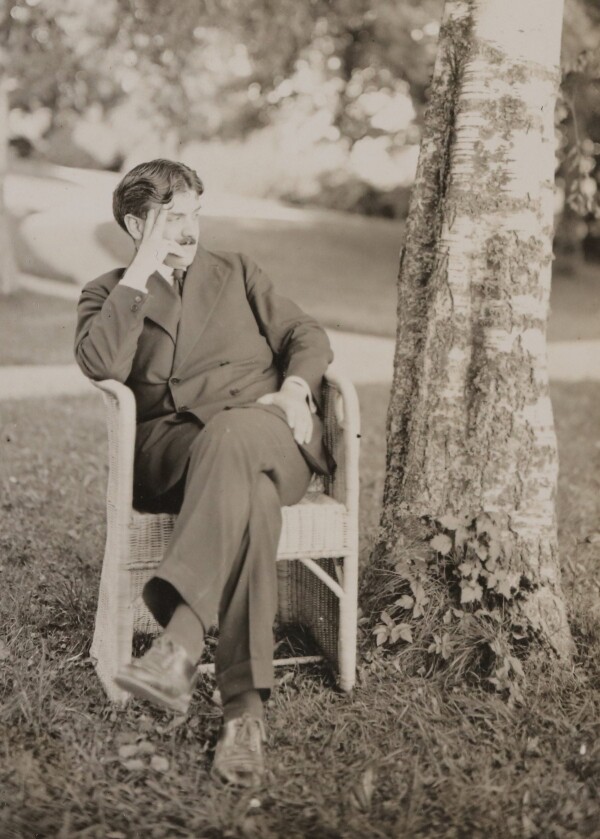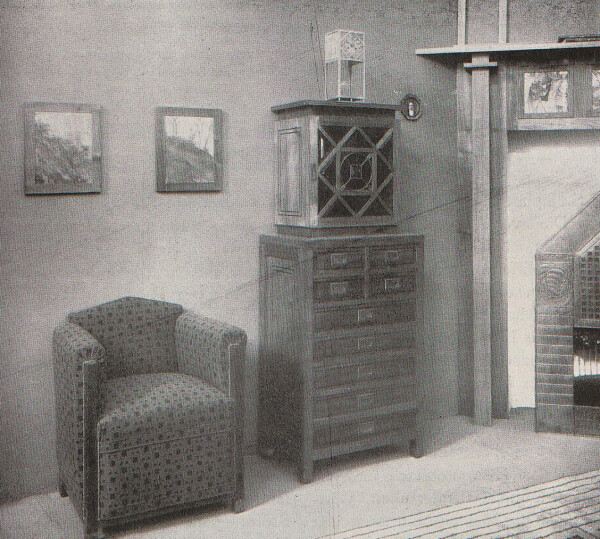Otto Prutscher

Otto Prutscher photographed by Friedrich Gerhard Walker, 1913, Villa Paulick Collection, Courtesy Klimt Foundation
© Klimt Foundation, Vienna

Otto Prutscher: Men's room in Italian acacia wood, in: Innendekoration, 17. Jg. (1906).
© Heidelberg University Library
Otto Prutscher was a Viennese architect and designer. He had been a student of Franz Matsch and Josef Hoffmann at the Vienna School of Arts and Crafts and later worked for the Wiener Werkstätte. Prutscher was personally acquainted with Gustav Klimt; he repeatedly visited him and the Flöge family during their sojourns on the Attersee.
Otto Prutscher, born in Vienna in 1880, successfully completed apprenticeships as a cabinetmaker and bricklayer and then graduated from the Educational and Research Institution for the Graphic Arts. In 1895 he received a Rothschild travel grant and visited the metropolises of Paris and London. Two years later he studied at the Vienna School of Arts and Crafts under Franz Matsch, Josef Hoffmann, and Willibald Schulmeister. In 1901 he finished his studies and thus belonged to the first generation of artists of the new millennium to have been trained under Secessionist influence.
Independence and Early Recognition
Prutscher soon worked as an independent designer and architect. After a short while he achieved great success with his decorative and clearly thought-out works, which were unmistakably marked by the Secessionist style. He supplied designs for the Backhausen textile factory, the Thonet furniture manufacturer, the Augarten porcelain manufactory, and the Wiener Werkstätte, among others.
As early as 1902, when he was only 22 years old, Prutscher participated in the “XIII. Ausstellung der Vereinigung bildender Künstler Österreichs Secession” [“13th Exhibition of the Association of Austrian Artists Secession”] and received the Great Silver Medal at the “1st International Exhibition of Decorative Arts” in Turin. For the “Kunstschau Wien” of 1908, co-initiated by Gustav Klimt and Josef Hoffmann, he designed the “Room for an Art Lover” and then also participated in the “Internationale Kunstschau Wien” in 1909.
Prutscher the Architect
The versatile artist intensified his activities as an architect particularly during the 1910s. In addition to residential buildings, Prutscher, who from 1908 on was a member of both the German and the Austrian Werkbund, designed numerous exhibitions until well into the 1930s and mostly planned interiors for coffee houses and stores, such as for the pharmacy “Zum goldenen Adler,” all of which clearly betray his aspirations to create a Gesamtkunstwerk or universal work of art.
Teaching Positions
In addition to his activities as an independent artist, Prutscher worked as an assistant at the Educational and Research Institution for the Graphic Arts as early as between 1903 and 1909, and from 1909 on taught at the Vienna School of Arts and Crafts, where upon Hoffman’s recommendation he was appointed head of the Open Drawing Salon for Tradespeople. His teaching career was interrupted by World War I, and between 1938 and 1945 he was banned from working as an art professor because of his marriage to a Jewish wife. After World War II, Prutscher returned to the University of Applied Arts in Vienna and taught there for another four years before his death in 1949.
Literature and sources
- Architektenlexikon. Wien 1770–1945. Otto Prutscher. www.architektenlexikon.at/de/480.htm (03/31/2020).
- Sandra Tretter, Peter Weinhäupl (Hg.): Gustav Klimt. Sommerfrische am Attersee 1900-1916, Vienna 2015, S. 45.
- Max Eisler: Otto Prutscher, in: Die Kunst. Monatshefte für freie und angewandte Kunst, Band 34 (1916), S. 168-172.
- Dekorative Kunst. Illustrierte Zeitschrift für angewandte Kunst, Band 32 (1923/24), S. 273-282.
- Felix Czeike (Hg.): Historisches Lexikon Wien, Band 4, Vienna 1995, S. 612.
- Österreichische Akademie der Wissenschaften (Hg.): Österreichisches Biographisches Lexikon 1815–1950, Band 8, Vienna 1983, S. 312-313.
- Christoph Thun-Hohenstein, Rainald Franz (Hg.): Otto Prutscher. Allgestalter der Wiener Moderne, Ausst.-Kat., MAK - Museum of Applied Arts (Vienna), 20.11.2019–17.05.2020, Vienna - Stuttgart 2019.
- Hermi Schedlmayer, Fritz Schedlmayer, Claas Duit (Hg.): Otto Prutscher 1880–1949. Architekt und Designer zwischen Tradition und Moderne, Basel 2020.
- Hans Vollmer (Hg.): Allgemeines Lexikon der Bildenden Künstler von der Antike bis zur Gegenwart. Begründet von Ulrich Thieme und Felix Becker, Band XXVII, Leipzig 1933, S. 437.
- Walter de Gruyter (Hg.): Allgemeines Künstler-Lexikon. Die bildenden Künstler aller Zeiten und Völker, Band XCVII, Berlin 2018, S. 99.

